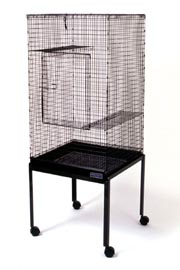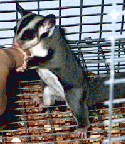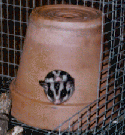|
Housing Adult gliders can tolerate a temperature range of 64° to 88°F (18°-31°C). At the low end of this range they definitely need warm bedding and a small enclosed space where they can cuddle to keep warm. The normal household is at the cool end of the spectrum for gliders, so make sure they can stay warm! I keep my glider room warmer than the rest of the house by using a thermostat-controlled space heater. It's usually about 80°F in there.
Making your own cage is the cheapest way to go, but when I do it I always end up sporting neat rows of evenly-spaced cuts on various parts of my body. :) Galvanized cage wire is the easiest to find; scrub it down good with a wire brush and then again with a sponge soaked in vinegar water, to get rid of any zinc left over from the galvanizing process. If you want to use a bird cage, you'll need to look for one with horizontal bars a maximum of 1/2-inch apart. The horizontal bars give them footholds for climbing that they wouldn't have in a cage with vertical bars. Gliders are very active and need lots of space for climbing and jumping, so the bigger your cage, the better!
Natural branches or rope perches for climbing are good additions to your cage, but make sure any branches you use are free of pesticides and are not from a plant that could be toxic. Fruit tree branches are good, and I've also used oak successfully. If you can find the large size exercise wheel made for guinea pigs, your gliders might learn to use it for exercise, but be sure not to get the smaller hamster size, as gliders can get their long tails caught in those, causing some serious injuries. Quality Cage also makes a large exercise wheel from the same materials as their cage; I like to line them with plastic needlepoint canvas (attached with zip ties) to prevent leg injuries. (It's not on their website so you'll have to ask for it.) Any feeding dishes that stay in the cage for non-perishable foods should be small enough not to tempt the gliders to sit in them while they eat, so as to avoid soiling their food. You can buy disposable paper trays in bulk from wholesale grocery stores so you don't have to wash dishes every night - this is especially helpful if you have a lot of gliders.
The down side to nest boxes of wood or clay is that although
the gliders won't soil the inside, they will mark the top and sides
with urine, so eventually they will need to be replaced. One solution
to this is to mount the nest box at the top of the cage so they can't
get on top of it, or hang the nestbox on the outside of the cage like
bird breeders do. Another is to use a cloth pouch that can be thrown in
the washer when it needs cleaning. The cloth pouch is a good way to go
when you are taming your gliders, because it makes catching them much
easier. See the section on taming
for more details. Be careful of woven fabrics that might ravel, though,
or seams that can come apart, because tiny loose threads can get
tangled around glider feet and tails and cut off the circulation.
Thermal fleece is my favorite fabric for gliders; it stands up well to
frequent washing and won't ravel, and is soft and warm.
|



